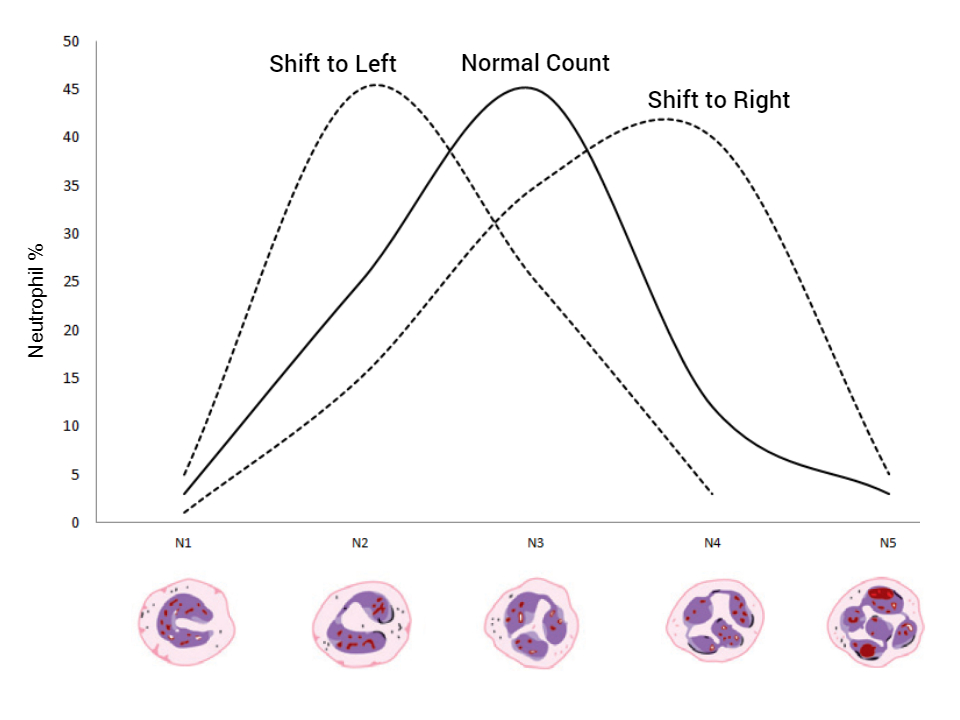| Stage | Nuclear lobes | Diagram | Normal Range |
|---|---|---|---|
| Stage 1 (N1) | Nucleus is unilobed. The nucleus is C or U shaped. |
 |
2-5% |
| Stage 2 (N2) | Nucleus is bilobed. Two lobes are separated by thin strands. |
 |
20-30% |
| Stage 3 (N3) | Nucleus is trilobed. Three lobes are separated by thin strands. |
 |
40-50% |
| Stage 4 (N4) | Nucleus is tetralobed. Four lobes are separated by thin strands. |
 |
10-15% |
| Stage 5 (N5) | Nucleus is pentalobed. Five lobes are separated by thin strands. |
 |
2-5% |
Principle of Arneth Count
The staging of neutrophils is based on the degree of maturity. The younger neutrophils contain fewer nuclear lobes than the older ones. The neutrophils enter the bloodstream mostly as bilobed cells, but the number of lobes increase to 5 or more by the end of their short life span of 8-10 hours.
Neutrophils are grouped into different types (N1, N2, N3, N4 and N5) on the basis of nucelar lobes by examining a stained smear under oil-immersion objective. In case of difficulty in determing nuclear lobes, two other parameters can be considered to stage the neutrophils.
- The number of granules: the younger cells contain more granules.
- The size oth the cell: cell size decreases as the cell advances on age.
Procedure
- Prepare a thin blood smear as in DLC, stain with Leishman/Wright’s stain.
- Examine the smear under low power objective to assess the distribution of cells.
- Count neutrophils under oil immersion objective as N1, N2, N3, N4 and N5 for neutrophils having 1, 2, 3, 4 and 5 nuclear lobes respectively. Count the cells in the same zigzag pattern as in DLC.
- Count at least 100 neutrophils and and enter your observations in a tabular format. Note the percentage distribution of various stages of neutrophils and plot a graph.
Clinical Significance of Arneth Count
The Arneth count is used to determine the number of younger or older neutrophils in the cirulation. As it reveals the production of neutrophils, it indirectly reflects the activity of the bone marrow. When there are more younger cells in circulation, the change is called shift to left and when there are more older cells in the circulation, the change is called shift to right.
Shift to Left
The total cells counted in N1, N2 and N3 are more than 80%. It indicates that bone marrow is hyperactive. Because left shift occurs due to increased production of cells, this is also called regenerative shift. Conditions related to this are:
- Acute pyogenic infections
- Tuberculosis
- Hemorrhage
- Irradiation
Shift to Right
The total cells counted in N4 and N5 are more than 20%. It indicates that bone marrow is hypoactive. Because right shift occurs due to hypofunction of bone marrow, this is also called degenerative shift. Conditions related to this are:
- Megaloblastic anemia
- Aplastic anemia
- Septicemia
- Uremia
References
- Pal, Gopal Krushna. Textbook of practical physiology. Orient Blackswan, 2001.
- Indu, Khurana. Textbook of medical physiology. Elsevier 1 (2009): 777.


Be the first to comment